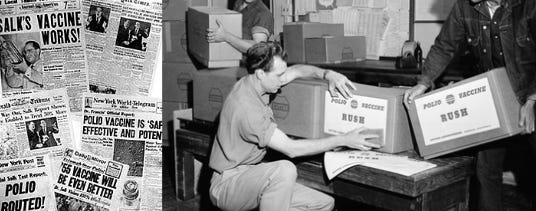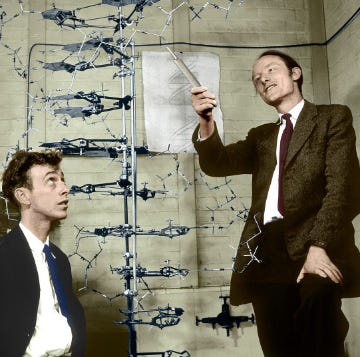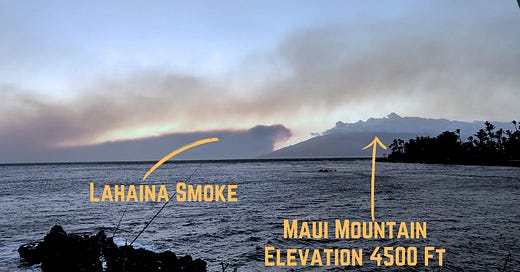
Discover more from Praying Mantis
From FDR to JFK (Part 1)
A hidden chapter in America's Medical History. A conspiracy of interests. All roads lead to Kennedy.
Franklin Delano Roosevelt was the 32nd president of the United States from 1933 until his death in 1945 and remains the longest-serving U.S. president. His first two terms were dedicated to addressing the Great Depression, while his third and fourth terms focused on America's involvement in World War II.
In 1938, Roosevelt founded the March of Dimes (originally the National Foundation for Infantile Paralysis) to combat polio, a disease he himself had been diagnosed with in 1921. Polio left him with lower-body paralysis, leading to his use of a wheelchair, though he was careful to limit its visibility to the public. He passed away in 1945, during his fourth term, with his health deteriorating significantly during the war. As World War II was nearing its end, FDR’s death had a profound impact on the nation.
In 1948, Dr. Jonas Salk began his work to classify the various types of poliovirus, dedicating the next seven years to developing a vaccine. Increased fear of polio, along with heightened publicity, led to substantial funding, with the March of Dimes playing a crucial role. Salk opted to use a 'killed' virus for his vaccine, which he believed was safer than the live, weakened virus strains being explored by Dr. Albert Sabin, who was simultaneously working on an oral polio vaccine that would later become the worldwide standard. In fact, the Sabin vaccine was given to 10 million children in the Soviet Union and he later was awarded the highest civilian medal of honor.
Monkey kidney cells were used in the production of the polio vaccine because they provided an ideal environment for the poliovirus to grow and replicate. The virus needed to be cultured in living cells to generate enough material for the vaccine, and at the time, rhesus monkey kidney cells were widely available and effective for mass production. One of the viruses present in these monkey cells was Simian Virus 40 (SV40).
On July 2, 1952, Salk injected 43 children with his killed-virus vaccine. A few weeks later, he conducted further tests at the Polk State School for the Retarded and Feeble-minded. In 1953, he even vaccinated his own children. By 1954, the vaccine was tested on approximately one million children, known as the "polio pioneers." In April 1955, the vaccine was officially declared safe.
After the successful trial, Cutter Laboratories was one of several companies licensed by the U.S. government to produce Salk's polio vaccine. These companies had pre-produced large stocks of the vaccine, which were released as soon as the licenses were signed.
During the vaccine's research phase, in 1951, Dr. Alton Ochsner, Chairman of Tulane Department of Surgery, injected his grandchildren with the Cutter vaccine during a demonstration. Tragically, his grandson died within seven days, and his granddaughter contracted polio but survived. Around the same time, NIH researcher Dr. Bernice Eddy was investigating issues with the vaccine. In 1954, she discovered that some inoculated monkeys had become paralyzed, identifying SV40 as a potential contaminant. Her findings were dismissed by NIH director William Sebrell.
Despite Eddy’s findings, the momentum was unstoppable—by April 12, 1955, the Salk vaccine, produced by Cutter Laboratories, was poised for mass distribution, ready to be unleashed despite the risks that had already surfaced.
"When ambition outpaces caution, the medicine that saves us today becomes the weapon that haunts us tomorrow."
Dr. Robert Oppenheimer
The Cutter incident remains one of the most catastrophic pharmaceutical disasters in U.S. history. Of the children vaccinated, 40,000 developed abortive poliomyelitis (a non-central nervous system form of the disease), 56 developed paralytic poliomyelitis, and tragically, five died. This outbreak triggered a ripple effect, with polio spreading through families and communities, causing 113 additional cases of paralysis and five more deaths.
When Dr. Bernice Eddy raised the alarm to the NIH and FDA about the contamination, her warnings were shelved. By 1956, millions worldwide had received the vaccine in an aggressive immunization campaign. In the U.S. alone, around 30 million children were vaccinated. Globally, hundreds of millions of doses were distributed, especially in wealthier nations that could afford mass immunization.
Within this same timeframe, molecular biology was just beginning. Watson & Crick had only recently published their discovery of the DNA double helix in 1953—a breakthrough that won them the Nobel Prize. Why is the fact important and relevant? At the time Salk was developing the polio vaccine, DNA science was in its infancy, and there was little understanding of how SV40 might impact human cells.
SV40's promoter aids in introducing foreign genetic material into a cell's nucleus, where it can interact with the DNA and RNA, potentially causing harmful mutations and cancer. Curiously, cancer rates in the U.S. began to climb significantly in the early 1970s. While various factors—such as better detection, an aging population, smoking, and chemical exposures—played a role, what was being kept from public knowledge about the vaccine's risks?
Consider Dr. Alton Ochsner, who was the first to link cigarette smoking to cancer—a groundbreaking discovery in itself. After the tragic consequences for his grandchildren and awareness of Dr. Eddy’s findings, Ochsner recruited Dr. Sarah Stewart, a leading virologist and cancer expert (later nominated for a Nobel Prize), and Dr. Mary Sherman, a bone cancer specialist and orthopeadic surgeon.
It appears that a very small circle of medical researchers and some within government intelligence agencies were aware that the US had just inoculated a cancer producing virus to millions around the world. Under the auspices of Ochsner, Stewart and Sherman established a covert bioweapons lab in New Orleans. Their mission: to find a way to remove SV40 from the human genome.
Instead, they discovered that with each radiation treatment, the virus became even more lethal. In their attempt to correct a monumental mistake, they unintentionally created a deadly bioweapon. As a footnote, among the clandestine lab’s personnel was a man with a name etched into history—Lee Harvey Oswald.
There is much more to this story, read about this in my next installment:
Heavenly Father,
We lift up every person who has been affected by vaccine injuries. Lord, we ask for healing in their bodies and protection from further harm. We stand not in fear, but in complete authority over our health, knowing that You have provided everything we need to thrive and fulfill our purpose in this life.
We call upon the heavenly host to battle against the nefarious forces that seek to kill and destroy. Expose those who have fallen into corruption, driven by the love of prestige, power, and money. May they repent and be brought to justice, whether here on earth or in the heavenly realms.
In Jesus’ holy name,
Amen.
Dr. Jack Kruse, a neurosurgeon and current advisor to Salvador’s President Nayib Bukele and Robert F. Kennedy, provides the context for this article which I supplemented with my own research. His entire mind blowing podcast is here:
Although Dr. Zelenko has passed, the company he created lives on. I highly recommend his supplements, click on this link to get at 15% discount and support my work:
Subscribe to Praying Mantis
Ignorance is bliss but information is power. I write to share so your loved ones start asking questions and seek answers for themselves. I mostly cover Election Security (or lack thereof) but sometimes the Lord points me elsewhere.


















GRATEFUL FOR your history on the polio vax and the elucidation of how the Pfizers of the world got their scent to mega profits. It started in the 50's when most of us were beyond naive. I will look forward to Part 2
Brilliant history lesson Thank you 🙏